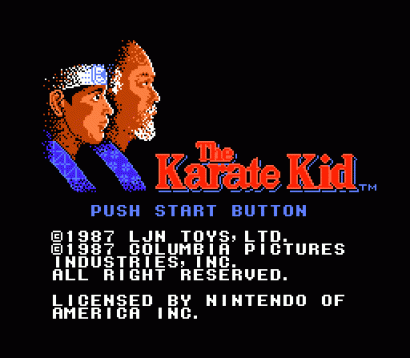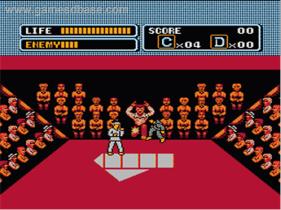Title: The Karate Kid
Platform: Nintendo Entertainment System
Publisher: LJN
Year: 1987
This review comes at the request of Kevin Wiesneski. You owe me, buddy.
We all loved The Karate Kid when it hit theaters. Heck, we still do. And everybody except the most curmudgeonly of joystick-era reactionaries and the most vapid of latter-day graphics snobs loves the good old Nintendo Entertainment System. So naturally, combining these two ’80s pop culture titans is a slam dunk, right? Let’s find out together!
The Karate Kid is a game I wasn’t altogether familiar with before my old pal Kevin requested I do a review of it. I’d read some things about it here and there, most of which had lead me believe it isn’t a very good game. The LJN logo on the cover certainly didn’t inspire notions to the contrary, based on past experience with such titles as Friday The 13th, Major League Baseball, The Uncanny X-Men (which I actually kind of like, in spite of itself), and the various junky WWF Wrestlemania games the company cranked out on the Nintendo. I’ve had The Karate Kid kicking around in my collection for some time now, but I never really played it apart from testing it to make sure that the thing actually worked. So, apart from the possibility of another terrible movie tie-in from LJN, I didn’t know what to expect going into this.
At first blush, the game looks and feels like a knockoff of mid-’80s one-on-one karate games like Karate Champ or International Karate. But beginning with Stage 2, the game becomes a side-scrolling beat-’em-up in the vein of Kung Fu and Black Belt. And the game has only four levels, which appear to be based more on The Karate Kid Part II than the original Karate Kid film. Stage 1 is the All Valley Karate Tournament from the end of the first movie, but stages 2, 3, and 4 take place in Japan, as does the bulk of Part II. Stage 3 recalls the typhoon scene from the second film, and Stage 4 puts you in a ruined Japanese castle and concludes the game with a boss battle against Part II‘s villainous Chozen Toguchi. The title screen even uses the poster artwork from Part II.
By rights, this game should have been entitled The Karate Kid Part II. Granted, consumers would doubtless have wondered what happened to the “first” Karate Kid game, but such naming conundrums never stopped companies like Sears, RCA, and Sears again from releasing products that often left gamers wondering where their progenitors were. (There were reasons for that which are more arcane than erroneous, but we won’t get into that here.)
I’ve read a lot about how this game is unplayably difficult due to broken mechanics, poor controls, and this and that. I didn’t find it to be that exactly, but there are a couple of things to know about the controls. The most useful attack by far is your basic kick, but there is a momentary delay between the press of the button and the execution of the kick due to it being a two-stage attack: a knee lift, followed by the kick itself. The kick itself is what takes bad guys out, leaving you vulnerable to attack during the knee-lift “setup,” which in turn makes learning the timing of the kick critical if you hope to get anywhere in this game at all. Punching is faster, but the range of the attack is short enough that by the time an enemy comes within punching range, he will probably have hit you once or twice.
There are two special attacks that Daniel-San can perform: the Crane Kick -the iconic move made famous by the first Karate Kid movie- and the Drum Punch. These moves are accessible by collecting sporadically appearing “C” and “D” icons and are usable only when you have some stockpiled.
Additionally, jumping is done by pressing “up” on the D-Pad; many gamers are less than fond of “Up To Jump,” and as a general rule I’m with them, but in this case I didn’t find it to be much trouble. The jumping physics remind me of those in the original Street Fighter, though.
Playing Tip: Progress methodically. Let enemies come to you and walk into your kicks.
I breezed through Stage 1 on my first attempt. I found Stage 1 altogether too easy. Like, Kelly Bundy easy. It requires little more than repeatedly kicking. Even Stage 2 didn’t put up much of a fight (see what I did there?) once I got the timing of my attacks down. I was starting to wonder where all the fuss about this game’s supposedly ludicrous difficulty had come from. But toward the middle of Stage 3, I was starting to see what they were talking about.
Stage 3 -the Typhoon level- is where some of the problems with the game’s physics become apparent. Chiefly, the rigid jumping and collision. Colliding with or being struck by an enemy or foreign object* results in your being flung helplessly backward, during which time you are still vulnerable to attack. In some sections of the game this can result in Daniel-San cheaply getting juggled around between enemies and whittled down to nothing without so much as an edgewise punch. But in Stage 3 these things more often resulted in instant deaths by getting bumped into water-filled pits, accompanied by frustration of Castlevanian proportions. In addition to the regular lot of red-suited hoodlums trying to bump you off, The Karate Kid’s typhoon level throws flying sticks and randomly-moving birds into the mix. It’s mildly comical to see the poor birds vainly flying against the hurricane wind, until you get smacked backwards into a watery death by an errant pigeon for the 57th time. The birds and flying sticks can be destroyed, but I found doing so almost as tricky as killing the Pterodactyl in Joust; it can be done, it’s just really hard.
(*Technically, as an American in Japan, you are the foreign object.)
Yet, I am unconvinced that The Karate Kid is as fundamentally, irretrievably terrible as the internet likes to portray it. I daresay it even has a few things going for it. Not a lot, but a few.
The game is not altogether bad in the audio-visual department. The graphics are clean and somewhat detailed, although the color palettes are a little on the bland side. The title screen music is a little shrill, and the in-game music and sound effects are relatively basic, but the sound and graphics are just effective enough to get the job done. They’re essentially what you’d expect from an early third-party NES title.
The relative variety of gameplay is a plus, as well. In addition to the one-on-one and side-scrolling elements of the game, The Karate Kid mixes things up with bonus stages, which can be accessed at various points in your journey. I personally enjoyed them, if only for the fact that they broke up the monotony of walking rightwards and kicking people and getting knocked into pits. The bonus stages require the player to do things like catch flies with chopsticks, avoid a swinging hammer (this part reminds me of tetherball), and smashing blocks of ice (another reference to Part II).

This swinging hammer can be purchased at your local hardware store in the Poe-esque Torture department.
Parts of this game are certainly difficult and irritating, but with practice and experience, The Karate Kid is not insurmountable. If there are people out there who can master such aneurism-inducingly difficult games as Mega Man, Battletoads, and Teenage Mutant Ninja Turtles, there’s no reason why The Karate Kid couldn’t be beaten by a player with the patience and inclination to do so. I am not that player (although after nearly 25 years, I’m pretty close with TMNT), but judging by the ending, it probably isn’t worth it anyway.
Playing Tip: When possible, run away from enemies. No more than two can be onscreen at a time (excluding birds and sticks); if you can keep them chasing you, the path ahead of you will be easier.
While I don’t think The Karate Kid is nearly as bad as it is often made out to be, I find it to be only marginal at best. And even though it’s an inexpensive and readily available cartridge that isn’t without some gameplay value, I would recommend it only to hardcore NES collectors -for completion’s sake- or budding retrogamers who stumble upon it at a thrift store and have nothing better to do with the couple of bucks it will cost. Ultimately, it just isn’t a very memorable game. Nothing about it really jumps out at you, and almost everything about it is firmly average (which is actually a huge compliment for an LJN title). Considering the Nintendo’s wealth of quality beat ’em ups such as River City Ransom, the Double Dragon and Teenage Mutant Ninja Turtles games, or the aforementioned Kung Fu, there’s just not enough here to make The Karate Kid worth going out of your way to pick up…unless you collect Karate Kid memorabilia or something (that’s probably a thing, right?). The Karate Kid falls into that lukewarm purgatory where it’s not quite good enough to play on its own merits, and not bad enough to play forteh lulz.
But it certainly isn’t the worst thing ever to have “The Karate Kid” slapped on it. (Or even the next worst.)
(c) 2013 Jeffery Koss




